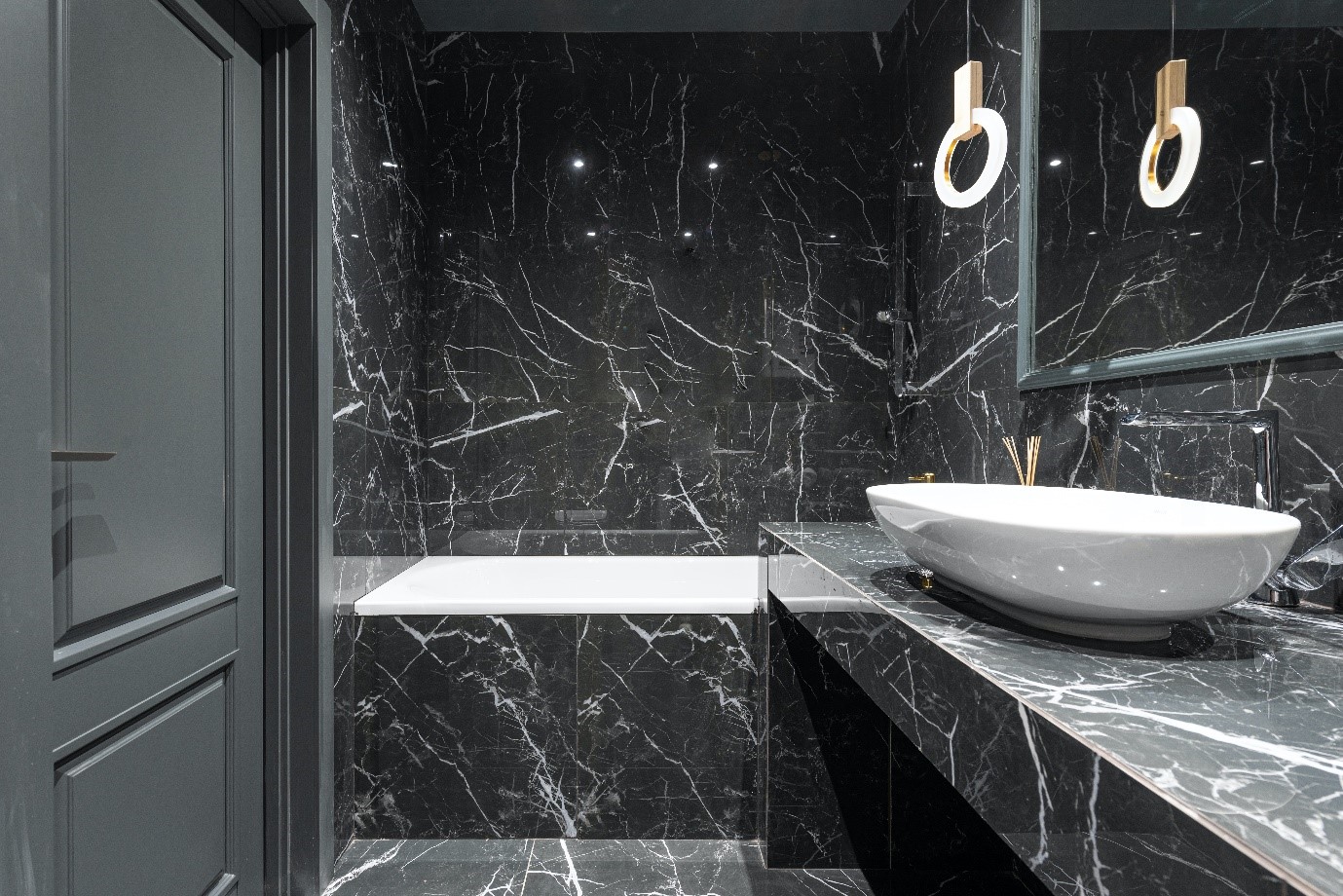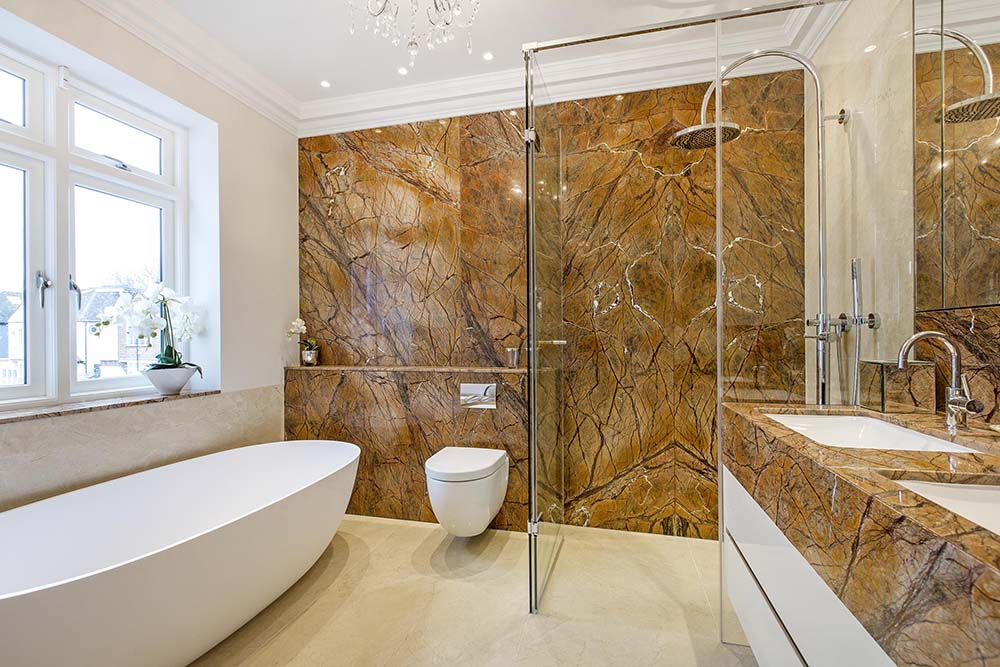The Timeless Elegance of Marble and Stone

Marble and stone have been integral elements in bathroom design for centuries, embodying luxury, sophistication, and enduring beauty. Their rich history and cultural significance contribute to a sense of timeless elegance that continues to captivate homeowners today.
The History and Cultural Significance of Marble and Stone
The use of marble and stone in bathroom design dates back to ancient civilizations. The Romans, renowned for their architectural prowess, extensively employed marble in their lavish baths, creating spaces of grandeur and opulence. Marble’s versatility, durability, and aesthetic appeal made it a preferred material for both structural and decorative purposes. The intricate mosaics and sculptures adorning Roman baths stand as testaments to the enduring legacy of marble in bathroom design.
In the Renaissance period, the rediscovery of classical art and architecture reignited the appreciation for marble and stone. Artists and architects, inspired by the grandeur of ancient Rome, incorporated these materials into their designs, creating spaces that exuded elegance and refinement. The iconic marble sculptures and fountains of the Renaissance period, such as Michelangelo’s David, exemplify the artistic mastery and timeless beauty of marble.
Throughout history, marble and stone have been associated with power, wealth, and prestige. Their use in bathrooms has often been a symbol of luxury and sophistication, reflecting the discerning taste and refined sensibilities of their owners.
The Luxury and Sophistication of Marble and Stone
Marble and stone possess inherent qualities that contribute to a sense of luxury and sophistication in bathroom design.
* Natural Beauty: The unique patterns, textures, and colors found in marble and stone create a sense of natural elegance and authenticity. Each piece is one-of-a-kind, adding a touch of individuality and character to the bathroom.
* Durability and Longevity: Marble and stone are known for their exceptional durability and longevity. They can withstand the wear and tear of daily use, maintaining their beauty for generations.
* Versatility: Marble and stone are highly versatile materials that can be used in various applications, from flooring and countertops to walls and shower enclosures. Their adaptability allows for a wide range of design possibilities, catering to diverse aesthetics and preferences.
* Elevated Aesthetics: The cool, smooth surface of marble and the rugged, textured appeal of stone create a sophisticated and luxurious ambiance. Their tactile qualities enhance the overall sensory experience of the bathroom.
Famous Bathrooms Featuring Marble and Stone
Many iconic bathrooms around the world showcase the timeless elegance of marble and stone.
* The Palace of Versailles: The opulent bathrooms of the Palace of Versailles in France feature intricate marble mosaics, ornate carvings, and lavish gold accents, reflecting the grandeur of the French monarchy.
* The Taj Mahal: The renowned mausoleum in India, known for its exquisite marble craftsmanship, includes a beautiful marble bathroom with intricate carvings and a serene atmosphere.
* The Roman Baths: The ancient Roman baths, such as the Baths of Caracalla, showcase the extensive use of marble in both structural and decorative elements, creating spaces of grandeur and opulence.
Types of Marble and Stone Used in Bathrooms, Marble and stone bathroom
The following table showcases different types of marble and stone commonly used in bathrooms, highlighting their unique characteristics, colors, and patterns:
| Type | Characteristics | Colors | Patterns |
|---|---|---|---|
| Carrara Marble | White with gray veining, fine-grained, smooth surface | White, gray, black | Linear, swirling, veined |
| Calacatta Marble | White with dramatic gray veining, bold patterns, polished finish | White, gray, gold | Dramatic, bold, veined |
| Statuary Marble | Pure white, fine-grained, smooth surface, delicate veining | White | Delicate, subtle veining |
| Travertine | Porous, textured surface, warm tones, natural holes | Beige, brown, cream | Rustic, textured, with natural holes |
| Granite | Durable, hard, resistant to scratches, wide range of colors | Black, white, gray, pink, green | Speckled, granular, veined |
| Onyx | Translucent, layered, iridescent, delicate veining | White, brown, green, orange | Layered, banded, veined |
Practical Considerations for Marble and Stone Bathrooms

Marble and stone bathrooms offer undeniable elegance and sophistication. However, their beauty comes with practical considerations that must be addressed to ensure both aesthetic appeal and longevity. This section delves into the pros and cons of using marble and stone in bathrooms, including their durability, maintenance requirements, and cost. We will also explore the importance of sealing these materials to protect against stains and water damage, and provide valuable tips for cleaning and maintaining marble and stone surfaces.
Durability and Maintenance
Marble and stone are naturally durable materials, resistant to wear and tear. However, they are also porous and susceptible to scratches, etching, and staining.
- Pros: Marble and stone are known for their longevity and durability, adding value to a home. Their natural beauty can withstand the test of time with proper care.
- Cons: While durable, these materials require regular maintenance to preserve their appearance. Etching and staining can occur if not properly sealed and cleaned.
Sealing Marble and Stone
Sealing is crucial for protecting marble and stone surfaces against stains and water damage. Sealants create a protective barrier that prevents liquids from penetrating the porous surface.
- Importance of Sealing: Sealing prevents stains from penetrating the surface, ensuring easy cleaning and maintaining the original beauty of the stone. It also protects against water damage, minimizing the risk of mold and mildew growth.
- Types of Sealants: There are various types of sealants available, including penetrating sealants, topical sealants, and impregnating sealants. The choice depends on the type of stone, the desired level of protection, and the frequency of maintenance.
- Frequency of Sealing: The frequency of resealing depends on the type of stone, the amount of traffic, and the level of exposure to water and cleaning agents. It is recommended to reseal marble and stone surfaces every 1-3 years.
Cleaning and Maintenance Tips
Maintaining the beauty of marble and stone requires regular cleaning and care. Here are some tips for keeping your surfaces looking their best:
- Use a pH-neutral cleaner: Avoid acidic cleaners, as they can etch the surface and damage the sealant. Choose a cleaner specifically designed for marble and stone.
- Clean spills immediately: Spills, especially acidic ones like wine or citrus juice, can quickly stain marble and stone. Clean them up immediately to minimize damage.
- Avoid abrasive cleaners: Abrasive cleaners can scratch the surface, dulling its shine. Opt for soft cloths and gentle cleaning agents.
- Use a soft-bristled brush: For stubborn stains, use a soft-bristled brush to gently scrub the surface. Avoid using harsh brushes or scouring pads.
Comparison of Marble and Stone Types
The following table compares different types of marble and stone based on their water absorption rates, scratch resistance, and overall durability:
| Type | Water Absorption Rate (%) | Scratch Resistance | Durability |
|---|---|---|---|
| Marble | 0.5-2.0 | Moderate | Moderate |
| Granite | 0.1-0.5 | High | High |
| Travertine | 2.0-4.0 | Low | Moderate |
| Slate | 0.5-1.5 | High | High |
Design Inspiration for Marble and Stone Bathrooms

Marble and stone, with their inherent elegance and durability, offer a canvas for diverse bathroom design styles. From traditional to contemporary, the versatility of these materials allows for a wide range of aesthetic expressions, transforming your bathroom into a haven of luxury and sophistication.
Integrating Marble and Stone into Bathroom Features
Marble and stone can be incorporated into various bathroom features, enhancing both functionality and aesthetics.
- Walls: Marble and stone walls add a touch of grandeur and sophistication to the bathroom. They can be used as feature walls, creating a focal point, or covering the entire space for a luxurious ambiance. Different finishes, such as polished, honed, or tumbled, can be chosen to create a desired aesthetic.
- Floors: Marble and stone floors are known for their durability and timeless appeal. They offer a variety of colors and patterns, allowing for customization and complementing different design styles. Tiles of varying sizes and shapes can be used to create intricate patterns or a clean, minimalist look.
- Countertops: Marble and stone countertops are a popular choice for bathrooms due to their elegant appearance and resistance to moisture and heat. They can be paired with various sink styles, from sleek, modern designs to traditional pedestal sinks, adding a touch of luxury to the space.
- Vanities: Marble and stone vanities can be custom-designed to create a unique and sophisticated statement piece in the bathroom. They offer ample storage space and a timeless aesthetic that complements a variety of design styles.
- Shower Enclosures: Marble and stone shower enclosures create a luxurious and spa-like experience. They can be customized with different tile patterns, mosaics, and glass accents, adding a touch of elegance and functionality to the shower space.
Bathroom Fixtures and Accessories
Selecting the right fixtures and accessories is crucial for enhancing the aesthetic appeal of a marble and stone bathroom.
- Faucetry: Chrome, brushed nickel, and gold finishes are popular choices for faucets in marble and stone bathrooms, complementing the luxurious feel of the materials. Consider sleek, modern designs for contemporary styles, or ornate, traditional designs for a classic ambiance.
- Lighting: Well-placed lighting can accentuate the beauty of marble and stone. Chandeliers, sconces, and recessed lighting can create a warm and inviting atmosphere, while accent lighting can highlight specific features, such as a marble countertop or a stone shower enclosure.
- Mirrors: Mirrors are essential in bathrooms, and they can be used to enhance the space and create a sense of grandeur. Consider oversized mirrors or mirrors with ornate frames to complement the luxurious feel of a marble and stone bathroom.
- Storage Solutions: Marble and stone bathrooms often benefit from elegant storage solutions that blend seamlessly with the design. Consider open shelving, cabinets with intricate detailing, or freestanding storage units made of materials like wood or metal to complement the overall aesthetic.
- Plants: Adding greenery to a marble and stone bathroom can soften the look and create a more welcoming atmosphere. Choose plants that thrive in humid environments, such as ferns, orchids, or peace lilies, and place them in decorative pots or planters to complement the design.
Blending Marble and Stone with Other Materials
Marble and stone can be beautifully integrated with other materials to create a cohesive and visually appealing bathroom design.
- Wood: The warmth of wood complements the cool elegance of marble and stone. Wood can be used for vanity cabinets, flooring, or decorative accents, adding a natural element to the space.
- Metal: Metal accents, such as chrome or brushed nickel fixtures, add a touch of sophistication and modernity to a marble and stone bathroom. Metal can also be used for decorative elements, such as towel bars, shelving, or lighting fixtures.
- Glass: Glass shower enclosures, decorative glass tiles, or glass accents on vanity cabinets can add a touch of lightness and elegance to a marble and stone bathroom. Glass can also be used for mirrors, creating a sense of space and reflecting light.
Marble and stone bathrooms are all about that timeless elegance, right? But sometimes, you want to add a little grit to that polished look. That’s where industrial style bathroom hardware comes in. Think exposed pipes, chunky metal fixtures, and maybe even a reclaimed wood shelf.
It’s a cool contrast that makes your marble and stone stand out even more.
Marble and stone bathrooms can be pretty fancy, but sometimes a more relaxed vibe is just what you need. If you’re looking for something a little more down-to-earth, check out a farmhouse style guest bathroom – they’re all about comfort and rustic charm.
And hey, you can still incorporate marble and stone accents in a farmhouse bathroom, like a reclaimed stone countertop or a vintage marble sink. It’s all about finding the right balance!